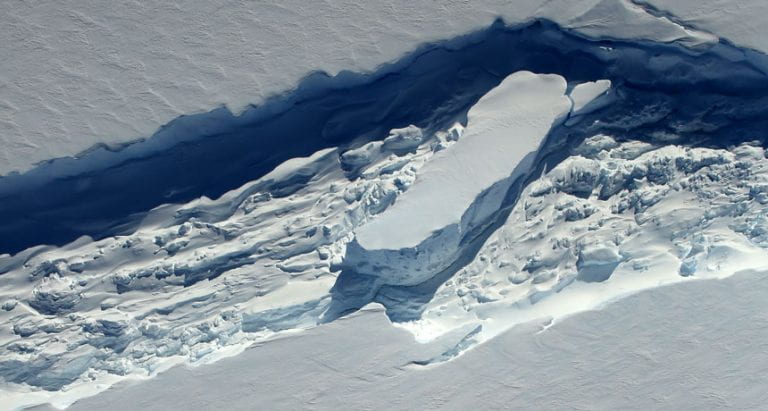Melting ‘glue’ may have sent the world’s largest iceberg to its doom, new study finds
Why are Antarctica's ice shelves collapsing?

The thinning of an icy "glue" that holds fractured ice together may drive ice shelf collapse in Antarctica, according to a new study.
Ice shelves are massive stretches of ice that build up over many thousands of years, Live Science previously reported. But warming air and rising ocean temperatures have been driving ice shelves to disintegrate. Many of Antarctica's ice shelves have fractured or collapsed in the past couple of decades, according to the new study, but exactly what's accelerating the ice loss has been unclear.
To figure this out, a group of glaciologists zoomed in on rifts on Antarctica's Larsen C Ice Shelf, which calved a Delaware-size iceberg called A68 in July 2017.
Related: In photos: Antarctica's Larsen C Ice Shelf through time
The split of A68, an iceberg approximately 2,240 square miles (5,800 square kilometers) in area, reduced the size of Larsen C by 12%, Live Science previously reported. Larsen C is the third ice shelf on Antarctica's western peninsula to undergo massive ice loss in the past two decades.
The prevailing theory was that these splits were happening due to a process known as hydrofracturing, in which pools of melted ice on the surface of ice shelves seep through the cracks and expand once they freeze again, co-author Eric Rignot, a professor of Earth system science at the University of California, Irving, said in a statement. "But that theory fails to explain how iceberg A68 could break from the Larsen C ice shelf in the dead of the Antarctic winter when no melt pools were present."
Rignot and his colleagues analyzed hundreds of rifts, or fractures, in the Larsen C Ice Shelf, using a model of ice sheets and sea level changes developed by NASA, as well as data from satellites and research aircraft. They zoomed in on 11 cracks and modeled three melting scenarios.
Sign up for the Live Science daily newsletter now
Get the world’s most fascinating discoveries delivered straight to your inbox.
Two out of the three scenarios focused on the role of "melange," a mix of windblown snow, frozen seawater and ice shelf fragments that exists inside and around rifts and typically works to seal the fractures, according to the statement.
In the first scenario, the glaciologists modeled what would happen if the ice shelf thinned due to melting; in the second, they modeled what would happen if the ice melange thinned; and in the third, they modeled what would happen if both the ice shelf and the melange thinned. Their simulations showed that the thinning of the melange controlled the rate at which the rift opened.
If the ice shelf thinned but the melange remained just as thick, the rift widening slowed down with time. In other words, the melange acted as a "healing" glue, fusing parts of the cracks. If both the ice shelf and the melange thinned, rift widening also slowed but not as much as it did in the first scenario. If the ice shelf remained the same but the melange thinned, as in the third scenario, the average annual rate of the rift widening increased from 249 to 367 feet (76 to 112 meters).
Just like sea ice, melange is vulnerable to the effects of warming oceans and rising air temperatures. "The melange is thinner than ice to begin with,” lead author Eric Larour, NASA Jet Propulsion Laboratory research scientist said in the statement.
Just 32 to 66 feet (10 to 20 m) of melange thinning is enough to reactivate a rift, or start to unzip it and trigger a major calving event, the authors wrote in the study. Reactivating a rift can trigger ice shelves to retreat decades before water ponding would cause hydrofractures on the ice sheet surface, they wrote.
"The thinning of the ice melange that glues together large segments of floating ice shelves is another way climate change can cause rapid retreat of Antarctica's ice shelves," Rignot said. "With this in mind, we may need to rethink our estimates about the timing and extent of sea level rise from polar ice loss — i.e., it could come sooner and with a bigger bang than expected."
The findings were published online Sept. 27 in the journal Proceedings of the National Academy of Sciences.
Originally published on Live Science.

Yasemin is a staff writer at Live Science, covering health, neuroscience and biology. Her work has appeared in Scientific American, Science and the San Jose Mercury News. She has a bachelor's degree in biomedical engineering from the University of Connecticut and a graduate certificate in science communication from the University of California, Santa Cruz.










